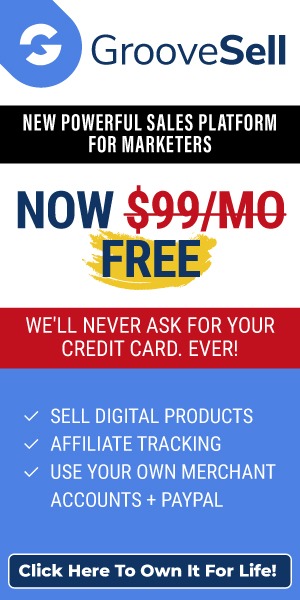
Step 1: Take Control Of The Buying Process
The most profits from Internet marketing come to those who own their own digital products and control the sales funnel.
A common sales funnel:
- Starts with a squeeze page to get a prospect’s name and email address.
- Then the main product
- Then one or more upsells and downsells (often referred to as one-time offers or OTOs).
There is two basic rules regarding sales funnels and corresponding upsells and downsells…
First – the one-time offers (i.e. upsells and downsells) relate to the main product offer in some way so that you add more value to the overall product offer.
Second – the one-time offers are optional purchases and NOT necessary to enable the main product offer to fulfill the value it is supposed to as described in the product’s sales letter.
The more people you can get to buy your main offer, the greater the chance that they will buy one or more of your one-time offers, since they have already purchased from you.
Step 2: It All Starts At The Squeeze Page
A squeeze page is just a Web page that offers the visitor something of value, such as a report on a specific topic of interest, in return for the person’s contact information (usually the person’s name and email address).
The information you provide in this free report should be useful to the person, but it should NOT include everything about the topic in question.
If you include all of the information in that free report, they’ll have no reason to buy any of your related offers, which is exactly the ultimate goal you have in mind for them.
The idea behind the squeeze page is to entice the visitor to willingly give up their name and email address so that you can follow up with them later with other relevant and useful information.
By doing this you can build a relationship with them and show that you are an expert in this industry or niche.
Once the prospect is comfortable enough with you, they will likely make a purchase, thereby entering your sales funnel.
Step 3: Offer A Directly Related PAID Product
Research has shown that it takes at least seven contacts with a prospect before they are willing to buy something from you.
Thus, you must contact the prospect by email to give them the link to download the free report offered on your squeeze page and to build up the relationship.
Good email marketing practices and building the relationship are key to making those sales.
Thus, you must provide more valuable information on the topic or subject in your follow-up emails to convince the prospect you are trustworthy and are respected in your field, eventually leading to him/her buying from you.
Don’t “hard-sell” in most of your follow-up emails; only “soft-sell” by providing valuable information about the topic, then adding a link to your main product page at the end of your emails.
Step 4: Now Is The Time To Slip In An Upsell or Downsell
After the prospect has turned into a customer by buying your main product offer, offer one or more offers designed to enhance the value of the main product offer, known as upsells and downsells.
Upsells are shown immediately after the main or previous product was purchased and are only available for that price at that moment; if the person leaves the page, the upsell deal is gone.
Downsells are shown immediately after an upsell offer is rejected; downsell offers are either the same upsell offer for a lower price or a slightly-reduced offer (one or more elements of the upsell offer is missing) at a lower price.
Upsells and downsells are not required to be purchased to get the value and benefits to the main offer; they are only optional purchases to enhance the value and features/benefits of the main offer.
Having a combination of upsells and downsells in your sales funnels will increase the chances for conversions and additional profits.
Most Internet marketers make the bulk of their profits on the back-end of the funnel (i.e. upsells and downsells), not from the front-end of the funnel (i.e. main product offer).
Step 5: Set Up Your Autoresponder Follow-Up Sequence
A series of around seven email messages will be sent out over about a two- week period after the prospect has requested the free report from your squeeze page.
The most convenient and easiest way to do this is to set up the email messages in your autoresponder; they’ll be sent out at pre-determined intervals automatically to the prospect.
- First message should include a link to download the free report and ensure the prospect has downloaded.
- Subsequent messages should look to build the relationship, show the prospect you’re trustworthy and knowledgeable in your field to build trust with him/her and convince him/her that he/she should buy your main product offer.
Out of seven email messages, no more than two should hard-sell your product; the others should only provide additional valuable information and include a link to your main product offer’s sales page at the end of your message.
Step 6: Test To Ensure Your New Sales Funnel Works
Testing to ensure your new sales funnel works before you present it to the public will ensure you don’t lose out on sales and new buyers to your email list.
Losing customers you would have had if your sales funnel worked properly will result in lost present and future profits.
A non-working sales funnel will also cause you to lose credibility in the eyes of your prospects/customers/subscribers and fellow Internet marketers.
Go through the funnel yourself, use the $0 or $0.01 payment option in such platforms as JVZoo, ClickBank, WarriorPlus, etc. to ensure the funnel works as it should at every stage.
Also ask other experienced Internet marketers to test your funnel to ensure it works for them, just to be sure the sales funnel works as it should before you present it to the public.
Step 7: Launch Your New Product
Set all price points to their proper values (especially if you were testing the funnel at $0 or $0.01) before you launch your product.
Start promoting your product via email marketing, forum marketing, social media, your blog/newsletter, paid advertising, joint ventures, and more.
The key is to get the word out about your new product and let the world know that the problem or issue they are dealing with can be effectively remedied or solved by your product.
Use testimonials from beta-testers of your product and from owners of previous versions of the product on your site and in your promotional material to convince people of the quality of your product to boost sales.
Use Google Analytics or other analytics software to determine how well your sales funnel is turning prospects into customers and one-time customers (i.e. the main product buyers) into repeat customers (i.e. upsell and downsell buyers).
Learn what parts of your funnel are performing as expected, underperforming, and overperforming to make modifications to the funnel and to learn what to do and what not to do in future product launches and sales funnels.













